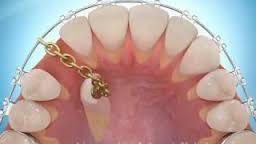All 8 year olds should have an orthodontic examination to make sure it’s all smiles when the eye teeth arrive.
Impacted canines provide a strong example of why early identification of orthodontic issues can make a huge difference. Impaction occurs when one or more teeth fails to grow in the correct position and is held below the normal gum line. This can be complete or unerupted impaction (where the tooth is buried) or partial impaction when just part of the tooth is visible in the mouth.
Everyone should have canine teeth in each upper and lower jaw. They are the “eye” teeth (fangs in animals) that are in line with the corner of the mouth. They have an important tearing function as well as being fundamental to the correct appearance of a smile. Normally, the adult canine teeth in the upper jaw appear in the mouth between the ages of 10 and 13 years. Just before then, they can usually be felt as bumps on the gum.
Out of all the teeth, canines have the longest path of eruption to travel from their initial formation to their final position in the mouth. Because of this, the canine tooth most commonly goes off course and becomes impacted. Canines can fail to grow completely on one or both sides; this can either leave a gap between the incisors and premolars or the “baby” canine tooth can be retained, which in time will look too narrow or too short. Misplaced canines can also grow in the wrong place. They can also erupt at the wrong angle or even behind the teeth in the palate.

As canines are very important for function and appearance, if they are impacted, your dentist should refer your child to an orthodontic team that includes an oral and maxillofacial surgeon as early as possible. Early treatment of impacted canines is the key to successful treatment. If diagnosed early, intervention by extracting the baby tooth results in the tooth erupting normally in 78% of cases.
If early diagnosis is missed, then a surgical procedure is required under a general anaesthetic to lift up the gum and bone surrounding the tooth, placing an attachment to the tooth and orthodontically bringing the tooth into the mouth. At this point the canine has usually erupted towards the middle of the palate behind the upper middle front teeth. Under these circumstances orthodontic treatment is usually a prolonged procedure sometimes taking as long as 3 to 4 years to correct the wayward tooth. That is why we recommend all children have an orthodontic examination at 8 years old. Early diagnosis and intervention is the key to avoid surgical procedures in the mouth and prolonged orthodontics

Big smiles all round
Some children will miss that all important early examination. At Moira Wong Orthodontics we have many years of experience in successfully dealing with impacted canines. Our team combines the orthognathic (jaw) surgeons and orthodontists that can ensure a bright and straight smile at the end of treatment. If your child has been diagnosed with impacted canines, please get in touch. They won’t have to give their eye tooth for a great smile!
